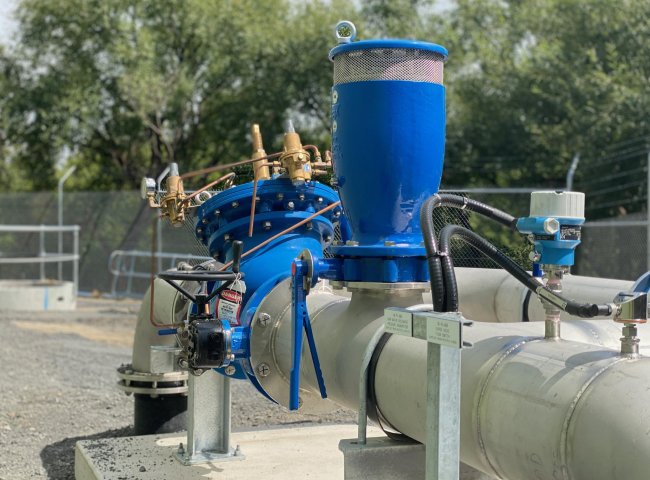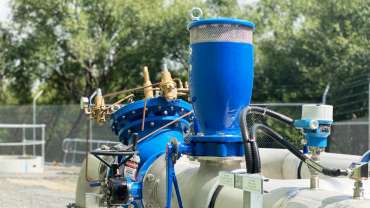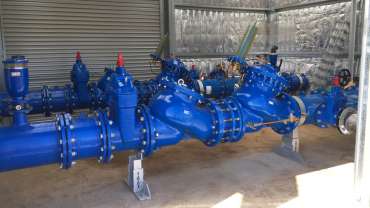![How does an air release valve work_Feature]()
This piece describes how air release valves operate within water systems to enable operators and users of air release valves to understand its operation and importance in pipeline systems.
What is the function of an air release valve?
An air release valve is typically used in water or irrigation schemes to ensure that any entrained air in the water system is automatically released in order to maximize the system performance. Entrained air pockets in pipes can cause excessive head loss and flow reductions if air is not effectively released.
The air release valve is also used during pipe drainage maximising the exiting outflow of water and at the same time ensuring the pipe is not subject to vacuum conditions.
It’s also designed to automatically release any entrained air that accumulates at the high spots during water transfer, maximizing the pipeline efficiency.
Finally, air valves have potential to generate water hammer under column separation conditions or excessive high fill rates of the pipe. Valves fitted with RFP (rapid filling prevention) designs ensure that the pipe cannot be filled at an uncontrolled rate that would induce water hammer.
Watch the following animation to see this function in action:
What are the main components of an air release valve?
- Valve body
The unique ductile Iron valve body is compact and houses the inner floats and upper mechanism. The body is designed so that the inlet is completely free of float guides, therefore enabling butterfly valves to be used directly under the air valve without impacting performance. Each valve body has a lower 316SS grade tamper proof drain valve enabling the valve to be drained and tested quickly and safely.
- Inner float assemblies
The inner floats are all manufactured from bar stock polypropylene which ensures they cannot ever change their mass or shape. The floats are all guided and kept square to the body by the four guide ribs on the valve body ensuring they cannot get blown offset to the side.
 The CSA Fox-RFP air valve design incorporates a multitude of elements to assist in the work to produce a combination air valve with rapid filling prevention.
The CSA Fox-RFP air valve design incorporates a multitude of elements to assist in the work to produce a combination air valve with rapid filling prevention.
The three floats assist in producing the three-general functions:
- Large orifice float
This enables air inflow and discharge during filling and drainage.
- Small orifice float
The small orifice float houses the nozzle subset, ensuring that the valve automatically releases any entrapped air when the pipe is full, and an air pocket presents itself in to the valve.
- RFP upper float
During pipe filling this float will remain open to fill the pipe at a controlled rate. If the exit flow rate exceeds a safe working rate, it immediately rises and chokes the air discharge to a safe operating rate, avoiding water hammer.
- Upper seat
The 316S grade stainless steel seat cleverly houses the O rings that make the seal between the seat and float.
- Mesh outlet and cover
The valve has a stainless-steel mesh that prevents any possibility in external contaminates fowling the inner floats and keeps vermin and spiders away from the underside of the cover. The ductile cover is robust and keeps any direct sunlight away from the floats and is strong enough to be stood on if fitted inside a valve pit.

How to operate the air release valve
The following animation highlights the features and benefits plus the operation of the air release valve functions described above.
Looking for additional support? We’re here to help.
Here at Bermad, we’re committed to providing the information you need for products, technology, and operating systems. That’s why we’re committed to ensuring that users of the CSA air-valves have the best information on the functions of all our products.
Please see a short video on how to clean and maintain the CSA Fox-RFP air valve in the field:
If you have any further questions, require additional details, or wish to discuss any technical aspects of the air release valve, you can:
- Visit the Fox-RFP valves page where all the data is present including data sheets, engineering assistance, 2D &3D cad drawings, manuals, case studies, spare parts, operational videos.
- Visit the Bermad training facility to get hands on training on the pressure reducing valve
- Contact our nearest sales office for discussions with the trained Bermad personnel.
- Use our live field support to assist in the operation of any valve.
If you wish to get hands on experience when it comes to the air release valve, you can visit the nearest Bermad training facility for an in-person demonstration.
Make enquiry
Online Enquiry Close
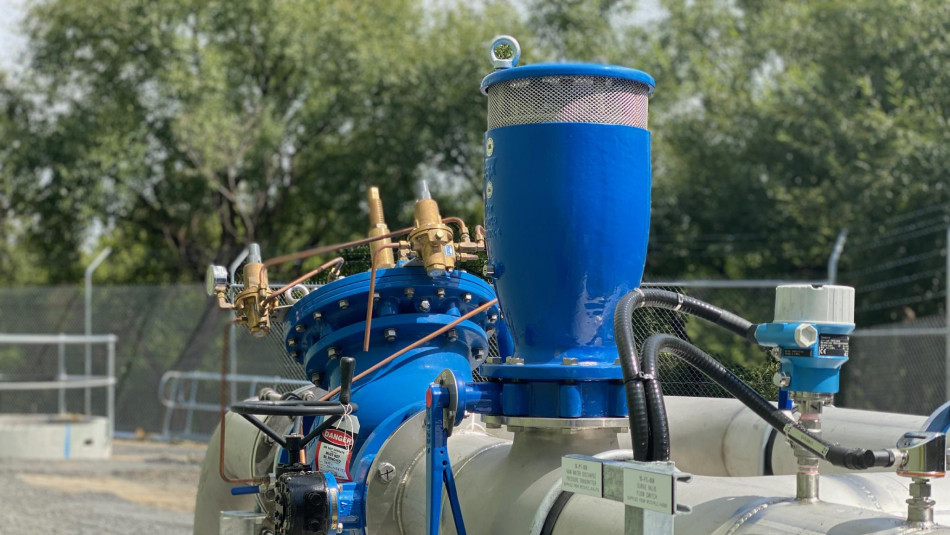
This piece describes how air release valves operate within water systems to enable operators and users of air release valves to understand its operation and importance in pipeline systems.
What is the function of an air release valve?
An air release valve is typically used in water or irrigation schemes to ensure that any entrained air in the water system is automatically released in order to maximize the system performance. Entrained air pockets in pipes can cause excessive head loss and flow reductions if air is not effectively released.
The air release valve is also used during pipe drainage maximising the exiting outflow of water and at the same time ensuring the pipe is not subject to vacuum conditions.
It’s also designed to automatically release any entrained air that accumulates at the high spots during water transfer, maximizing the pipeline efficiency.
Finally, air valves have potential to generate water hammer under column separation conditions or excessive high fill rates of the pipe. Valves fitted with RFP (rapid filling prevention) designs ensure that the pipe cannot be filled at an uncontrolled rate that would induce water hammer.
Watch the following animation to see this function in action:
What are the main components of an air release valve?
- Valve body
The unique ductile Iron valve body is compact and houses the inner floats and upper mechanism. The body is designed so that the inlet is completely free of float guides, therefore enabling butterfly valves to be used directly under the air valve without impacting performance. Each valve body has a lower 316SS grade tamper proof drain valve enabling the valve to be drained and tested quickly and safely. - Inner float assemblies
The inner floats are all manufactured from bar stock polypropylene which ensures they cannot ever change their mass or shape. The floats are all guided and kept square to the body by the four guide ribs on the valve body ensuring they cannot get blown offset to the side.The CSA Fox-RFP air valve design incorporates a multitude of elements to assist in the work to produce a combination air valve with rapid filling prevention.
The three floats assist in producing the three-general functions:
- Large orifice float
This enables air inflow and discharge during filling and drainage. - Small orifice float
The small orifice float houses the nozzle subset, ensuring that the valve automatically releases any entrapped air when the pipe is full, and an air pocket presents itself in to the valve. - RFP upper float
During pipe filling this float will remain open to fill the pipe at a controlled rate. If the exit flow rate exceeds a safe working rate, it immediately rises and chokes the air discharge to a safe operating rate, avoiding water hammer. - Upper seat
The 316S grade stainless steel seat cleverly houses the O rings that make the seal between the seat and float. - Mesh outlet and cover
The valve has a stainless-steel mesh that prevents any possibility in external contaminates fowling the inner floats and keeps vermin and spiders away from the underside of the cover. The ductile cover is robust and keeps any direct sunlight away from the floats and is strong enough to be stood on if fitted inside a valve pit.
How to operate the air release valve
The following animation highlights the features and benefits plus the operation of the air release valve functions described above.
Looking for additional support? We’re here to help.
Here at Bermad, we’re committed to providing the information you need for products, technology, and operating systems. That’s why we’re committed to ensuring that users of the CSA air-valves have the best information on the functions of all our products.
Please see a short video on how to clean and maintain the CSA Fox-RFP air valve in the field:
If you have any further questions, require additional details, or wish to discuss any technical aspects of the air release valve, you can:
- Visit the Fox-RFP valves page where all the data is present including data sheets, engineering assistance, 2D &3D cad drawings, manuals, case studies, spare parts, operational videos.
- Visit the Bermad training facility to get hands on training on the pressure reducing valve
- Contact our nearest sales office for discussions with the trained Bermad personnel.
- Use our live field support to assist in the operation of any valve.
If you wish to get hands on experience when it comes to the air release valve, you can visit the nearest Bermad training facility for an in-person demonstration.
Make enquiry
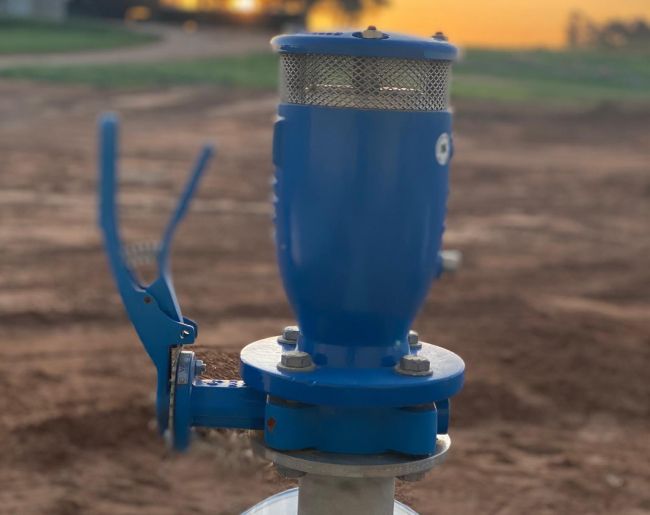 The CSA Fox-RFP air valve design incorporates a multitude of elements to assist in the work to produce a combination air valve with rapid filling prevention.
The CSA Fox-RFP air valve design incorporates a multitude of elements to assist in the work to produce a combination air valve with rapid filling prevention.